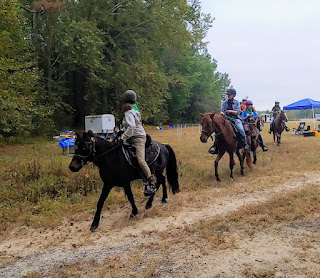Certain forms of equine assisted therapy use the horse and the person's reaction to the horse as a diagnostic tool with the primary goal being self understanding. For example, the person enters the round pen, seeks to interact with the horse and then discusses the feelings that resulted from the contact with the horse. If the horse evades the person it is important to understand why the horse was doing so and to examine how that evasion made the person feel.
A similar process can be applied to riding anxiety. All too often the answer to the question of "what are you afraid of when riding?" is the shallow response of "I'm afraid that I am going to fall off."
Of course, the issue is much more complex than that. No one wants to fall off but most experienced riders are not controlled by the fear of falling. Instead they have adapted strategies to control that fear. Often, the first step in dealing with riding anxiety is to change one's priorities in a manner that can be very surprising. Riders whose top priority is to stay on the horse are much more likely to be injured than are those whose top priority is to control the horse's speed and direction.
Such a rider is merely holding on and hoping for the best instead of focusing on bringing the animal to a safe stop. The rider who focuses on control of the horse will make sure that he is not squeezing the horse with his legs. If the rider has practiced one rein stops, using the left rein to bring the horse under control by keeping its head down and pulling its nose toward its hip, the horse can generally be brought back under control.
But there is a catch to this simple advice. When we feel an immediate physical threat our instincts prompt us to draw our bodies into a fetal position. When on horseback doing so will often result in feet being pulled from the stirrups at the same time that the head and shoulders are pulled downward and forward. When in such a position one is at much more risk of falling off and one is in a position that makes it impossible to use the reins to control the horse.
Overcoming learned behavior that is dangerous is hard enough, but learning to overcome instinctual behavior is quite a daunting task. The only way that I have been able to do so is to be perfectly consistent in how I handle the reins and where I place my legs. Every time that I stop a horse I use a left hand, one rein stop. After doing so for a few decades habit overcomes instinct.
If my horse bolts I do not have to decide what to do. My body instantly works to take control of the horse because each time I get on a horse my top priority is to control the horse's speed and direction.
Knowing that I can control the horse allows me to ride with less fear. Few things scare horses more than exposure to terrified people. the calmer one is around the horse the more likely the horse is to remain calm. One must also understand that being controlled in a perfectly consistent manner provides the horse with the same feeling of security that he feels in a small band of horses with the lead horse present.
Learn to control your horse. Learn to control your anxiety in the saddle. When it comes to horse/human relation sips fear is contagious.
So is peacefulness.



No comments:
Post a Comment